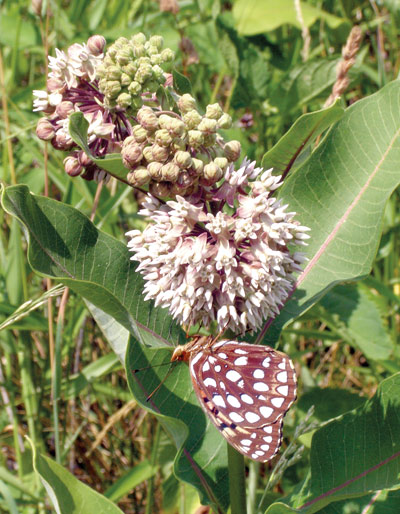The art of nature
Originally published July 10, 2008

An Aphrodite Fritillary is just one of several butterfly species attracted to the common milkweed. Photo by Ken Moore
By Ken Moore
Perhaps it’s really the nature of art! Art and nature were inseparable during the recent two-week Session 3 at Penland School of Crafts in Western North Carolina. Fifteen different studios — including glass blowing, metal sculpture, ceramics, photography, weaving and sketching — demonstrated that images and experiences of nature were dominant sources of inspiration expressed in the works of instructors and students.
Robert Johnson’s “Nature Journaling: Art for Nature Freaks†was clearly all about nature. I was fortunate to be Robert’s botanist assistant. We enjoyed day-long field trips, including viewing rare Gray’s lilies atop Roan Mountain’s grassy balds and close-up encounters with tiny sundews and bladderworts in a hidden mountain sphagnum bog. We brought examples of common species back to the studio to help us with continued detailed drawing.
The flora star was none other than the common milkweed, Asclepias syriaca. Not only did the several stems displayed on the botanical specimen table persist in good condition, but the fragrance of the flower clusters perfumed the entire studio, making quite an impression with numerous visitors from the other studios. Not surprisingly, many of the students labored happily on botanical details of this milkweed, common throughout the state.
In addition to serving as host plant for the monarch and other butterfly species, the common milkweed has a fascinating heritage of edible, medicinal and utilitarian uses. One of my favorite sources of facts and stories of native plants is Tom Brown’s Field Guide: Wild Edible and Medicinal Plants. The beginning of his description of the “personality†of the milkweed from his early-childhood experiences should encourage you to check out this informative and enjoyable reference: “Gathering dried milkweed stalks in late fall for cordage always turned into a fun-filled adventure. We picked a day that was bright and sunny and filled with mild but gusty wind – a day we were sure that the milkweed skeletons were turning from green to gray. This graying was the best indicator of the finest cordage, especially when it was meant for leaders on our fishing lines. Gathering consisted of cutting the old stems, stripping the old leaves and scattering the parachute-like downy seeds. This seed sowing was usually done with the utmost artistic movements.â€
Brown goes on to describe the laborious preparation of the milkweed as a delicious potherb, but I would proceed with great caution before I would ever pursue such an adventure.
A few of the hundreds of milkweeds in Chapel Hill’s Merritt Meadow are still in flower. There are probably a great variety of butterflies hovering about out there. In Carrboro, there are some handsome plants to attract butterflies in the curbside garden of N.C. Crafts Gallery and in the wild garden along the Frances Shetley Bikeway.
It was a second milkweed, the poke milkweed, Asclepias exaltata, with leaves very similar to American pokeweed, that really fired up the students’ artistic creativity. Occurring only in the western mountain counties, poke milkweed has creamy-colored flowers hanging in loose, open clusters, in dramatic contrast with the common milkweed’s tight clusters of pink flowers. Drawings of the poke milkweed took a turn more toward graphic design rather than the botanical accuracy students sought for the common milkweed. Taking a closer look at milkweed flowers can make artists of us all.


Comments are closed.